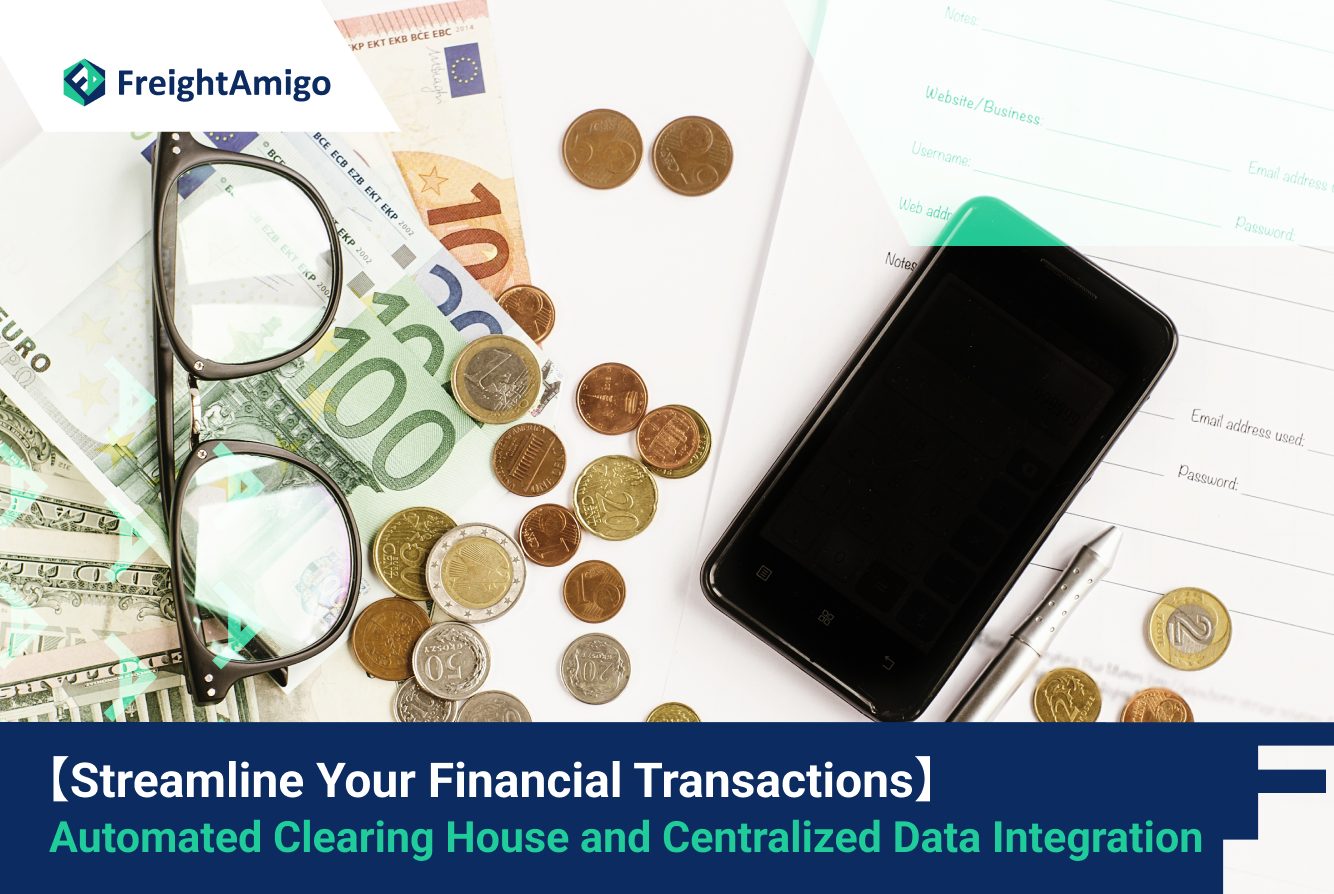Author Name: Tiffany Lee – Marketing Analyst at FreightAmigo
Understanding Automated Clearing House (ACH) payments
The world of finance is constantly evolving, and businesses are always on the lookout for innovative solutions to streamline their financial transactions. One such solution that has gained popularity in recent years is the Automated Clearing House (ACH) payment system. But what exactly are ACH payments, and how can they benefit businesses?
ACH payments refer to electronic payments that are processed through the Automated Clearing House network. This network serves as a central clearinghouse for financial transactions, enabling the transfer of funds between different banks and financial institutions. Unlike traditional paper checks, ACH payments are processed electronically, making them faster, more efficient, and less prone to errors.
Want To Compare The Best Express, Air Freight, Sea Freight, Rail Freight & Trucking Rates So As To Have Better Control On Cost?
The benefits of ACH payments for businesses
There are several advantages that businesses can enjoy by adopting ACH payments. Firstly, ACH payments offer a significant cost-saving advantage over traditional payment methods. With ACH payments, businesses can avoid the costs associated with printing and mailing paper checks, as well as the fees charged by third-party payment processors. This can result in substantial savings for businesses, especially those that process a large volume of transactions on a regular basis.
Additionally, ACH payments offer enhanced convenience for both businesses and their customers. With ACH payments, businesses can automate their payment processes, eliminating the need for manual data entry and reducing the chances of errors. This not only saves time but also improves accuracy and reduces the risk of payment delays or disputes. For customers, ACH payments offer the convenience of automated recurring payments, making it easier for them to manage their finances and ensure timely payments.
How ACH payments work
To better understand the benefits of ACH payments, it is important to grasp how they work. The ACH payment process typically involves three main parties: the originator, the receiver, and the ACH operator. The originator refers to the business or individual initiating the payment, while the receiver is the party receiving the payment. The ACH operator, on the other hand, acts as an intermediary, facilitating the transfer of funds between the originator and the receiver.
The ACH payment process begins with the originator submitting a payment instruction to their financial institution. This instruction contains all the relevant details of the payment, such as the amount, the receiver’s account information, and the payment date. The originator’s financial institution then transmits this payment instruction to the ACH operator, who verifies the details and processes the payment. Finally, the ACH operator transfers the funds from the originator’s account to the receiver’s account, completing the payment process.
What is CDI integration?
While ACH payments offer numerous benefits on their own, businesses can further enhance their financial transactions by integrating ACH with CDI (Centralized Data Integration). CDI integration refers to the process of combining the capabilities of ACH payments with advanced data integration services. This integration allows businesses to streamline their financial operations, improve efficiency, and gain valuable insights from their payment data.
The advantages of integrating CDI with ACH payments
Integrating CDI with ACH payments offers several advantages for businesses. Firstly, it enables businesses to automate their payment reconciliation processes. By integrating ACH payments with CDI, businesses can automatically match payment data with corresponding invoices or purchase orders, eliminating the need for manual reconciliation. This not only saves time but also reduces the risk of errors and ensures accurate financial reporting.
Furthermore, CDI integration allows businesses to unlock the full potential of their payment data. By consolidating payment data from various sources and systems, businesses can gain valuable insights into their financial performance, customer behavior, and market trends. These insights can help businesses make informed decisions, optimize their cash flow, and identify areas for improvement. With CDI integration, businesses can turn their payment data into a strategic asset, driving growth and profitability.
Streamlining financial transactions with ACH and CDI integration
The integration of ACH and CDI offers businesses a comprehensive solution for streamlining their financial transactions. By combining the speed and efficiency of ACH payments with the advanced data integration capabilities of CDI, businesses can achieve greater operational efficiency, reduce costs, and improve overall financial management.
One of the key benefits of ACH and CDI integration is the ability to automate payment processes. With automated payment reconciliation, businesses can eliminate manual data entry, reduce errors, and ensure accurate financial reporting. This automation also enables businesses to expedite the payment process, resulting in faster fund transfers and improved cash flow management.
Furthermore, ACH and CDI integration provides businesses with real-time visibility into their financial transactions. By consolidating payment data from different sources, businesses can have a centralized view of their payment activities, allowing for better tracking, monitoring, and analysis. This enhanced visibility enables businesses to identify potential issues or anomalies promptly and take appropriate action to mitigate risks.
ACH payment security and fraud prevention measures
While ACH payments offer numerous benefits, it is essential for businesses to prioritize security and fraud prevention. Fortunately, the ACH network has implemented robust security measures to safeguard transactions and protect sensitive information.
The ACH network utilizes various security protocols, such as encryption and authentication, to ensure the confidentiality and integrity of payment data. Additionally, financial institutions have implemented multi-factor authentication and fraud detection systems to prevent unauthorized access and fraudulent activities. These measures, combined with ongoing monitoring and risk management practices, provide businesses with a secure environment for conducting ACH payments.
To further enhance security, businesses should also implement internal controls and best practices. This includes regularly monitoring account activity, educating employees about security risks, and implementing strong password policies. By taking a proactive approach to security, businesses can minimize the risk of fraud and protect their financial transactions.
Common misconceptions about ACH payments
Despite the numerous benefits of ACH payments, there are still some common misconceptions that persist. One of the most prevalent misconceptions is that ACH payments are slow. While it is true that ACH payments may take longer to process compared to instant payment methods, such as credit card transactions, they are still significantly faster than traditional paper checks. In most cases, ACH payments are processed within one to two business days, providing businesses with timely fund transfers.
Another misconception is that ACH payments are only suitable for large businesses. In reality, ACH payments can benefit businesses of all sizes, from small startups to multinational corporations. The cost-saving advantages, convenience, and automation offered by ACH payments make them an attractive option for businesses looking to streamline their financial operations.
Exploring alternative payment methods to ACH
While ACH payments offer numerous advantages, it is important for businesses to explore alternative payment methods that may better suit their specific needs. One such alternative is cryptocurrency payments. Cryptocurrency, such as Bitcoin, offers fast, secure, and borderless transactions, making it an appealing option for businesses operating in the digital economy.
However, it is worth noting that cryptocurrency payments come with their own set of challenges and considerations. The volatility of cryptocurrency prices, regulatory uncertainties, and the need for specialized infrastructure and knowledge are factors that businesses should carefully evaluate before adopting cryptocurrency as a payment method.
Conclusion
In conclusion, Automated Clearing House (ACH) payments provide businesses with a cost-effective, convenient, and efficient solution for streamlining their financial transactions. By integrating ACH payments with CDI, businesses can further enhance their financial operations, automate payment reconciliation, and gain valuable insights from their payment data. With robust security measures in place, ACH payments offer a secure environment for conducting financial transactions.
While ACH payments offer numerous benefits, businesses should also explore alternative payment methods to find the best fit for their specific needs. Whether it is cryptocurrency payments or other emerging payment technologies, businesses should carefully evaluate the advantages and challenges of each option before making a decision.
By embracing innovative payment solutions and continuously adapting to the evolving landscape of finance, businesses can position themselves for success in an increasingly digital and interconnected world.
Ready to streamline your financial transactions and unlock the full potential of your payment data? Explore the benefits of ACH and CDI integration for your business today!
There Are Different Options For Cargo Transportation. If You Want To Choose The Most Convenient And Suitable Solution, It Is Best To Have The Full Support Of Logistics Experts! If You Are Planning To Ship Goods Overseas, Please Go To The FreightAmigo Page For Inquiries.
===
Read More:
【Export of USA】 A Gateway to Success and Global Economic Influence
The Key Trade Partners of the USA: Boosting International Commerce
【Export of USA】 US-China Trade War’s Influence on USA’s Export Industry
===
If you have any inquiries on logistics/supply chain, feel free to contact FreightAmigo now:
Chat with us online OR
Phone : +852 28121686
WhatsApp: +852 27467829









































